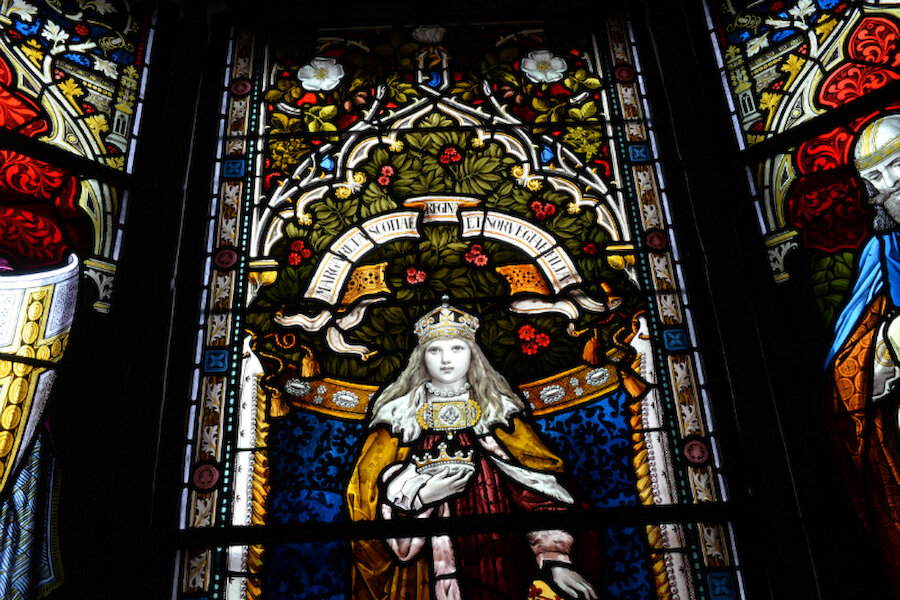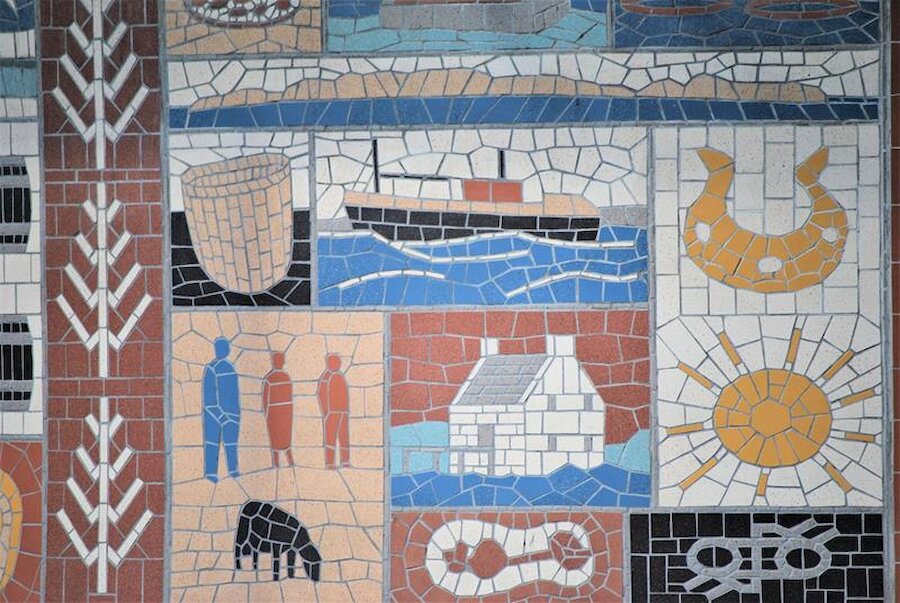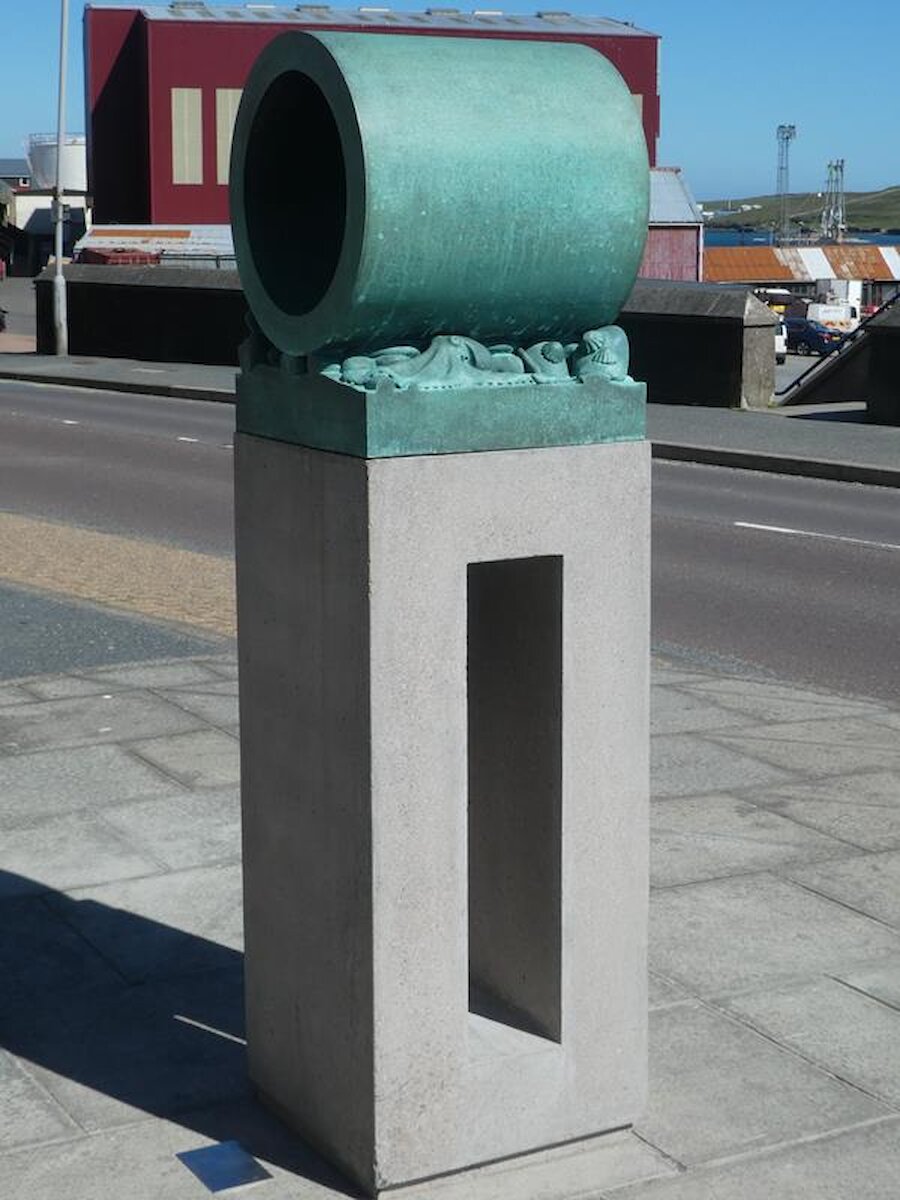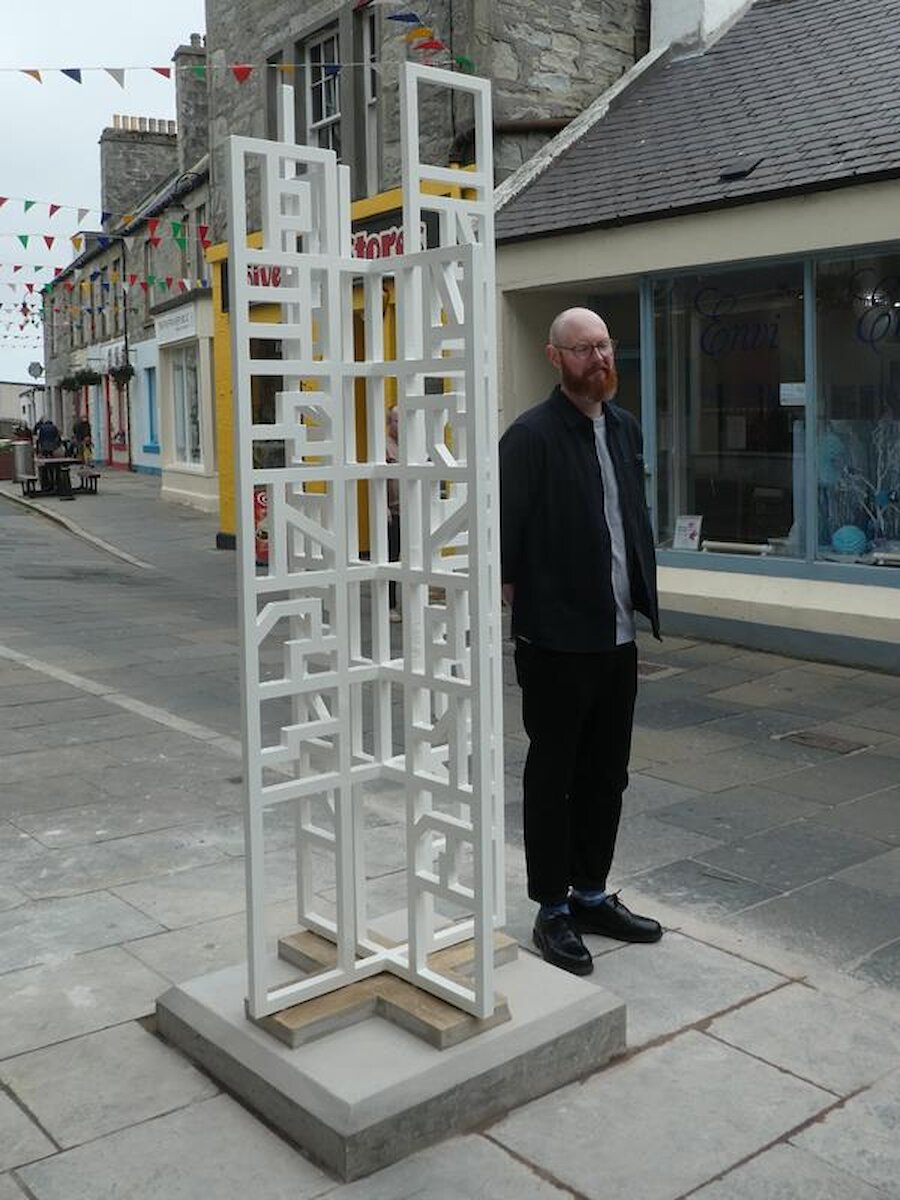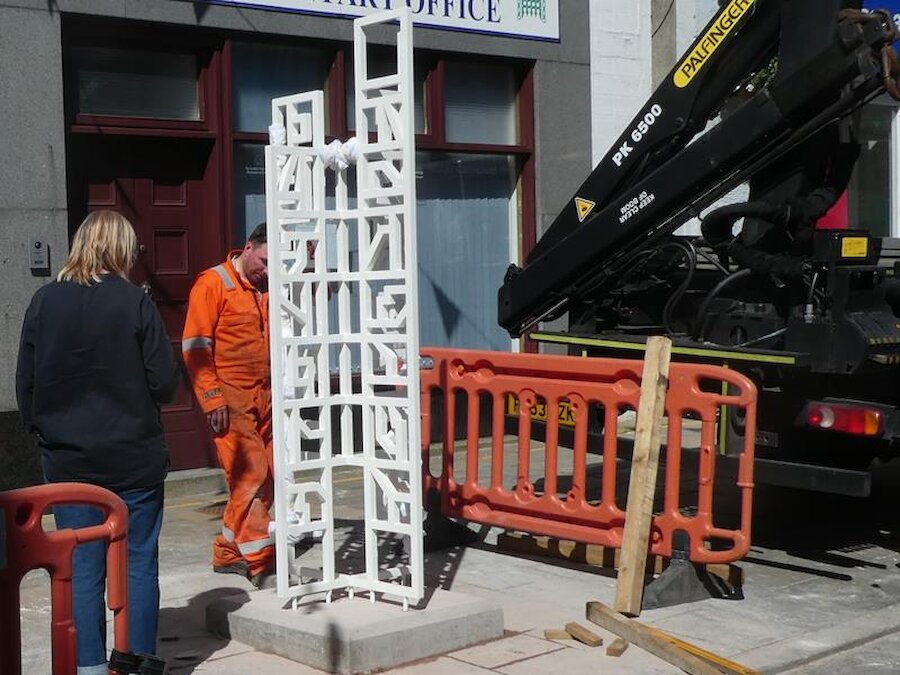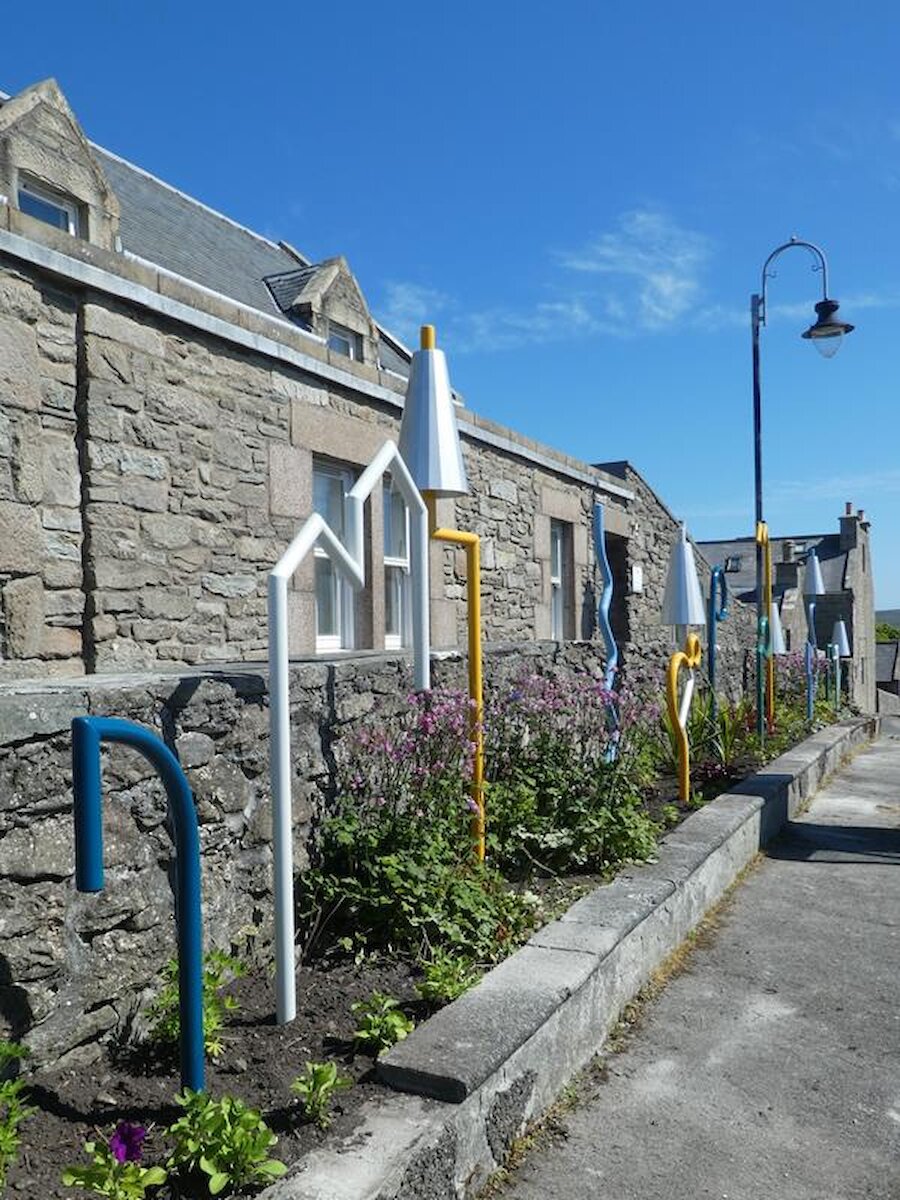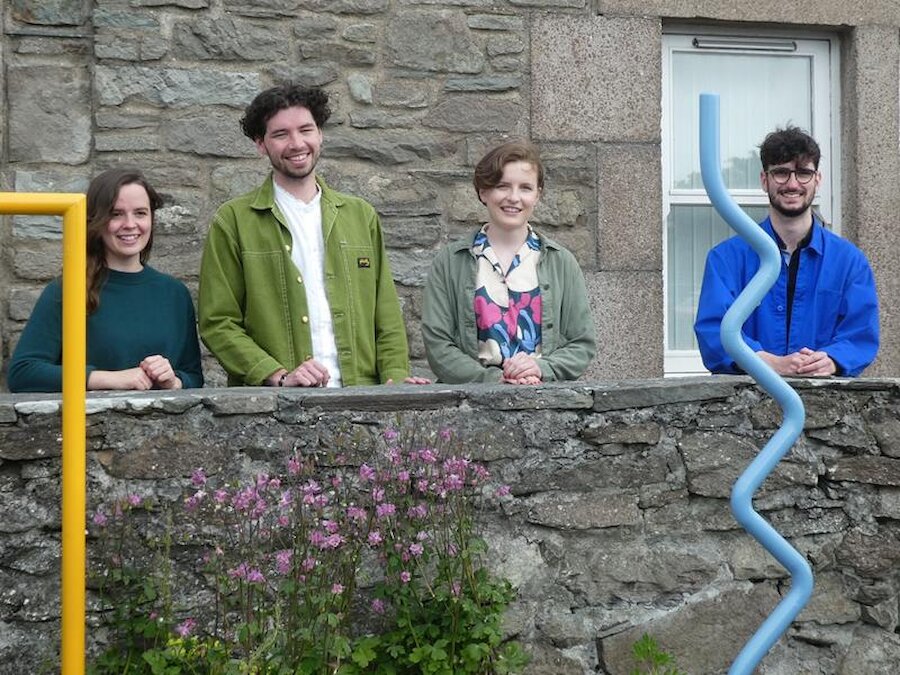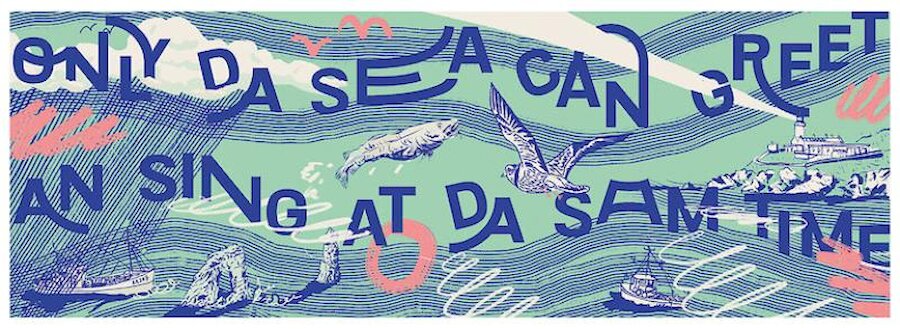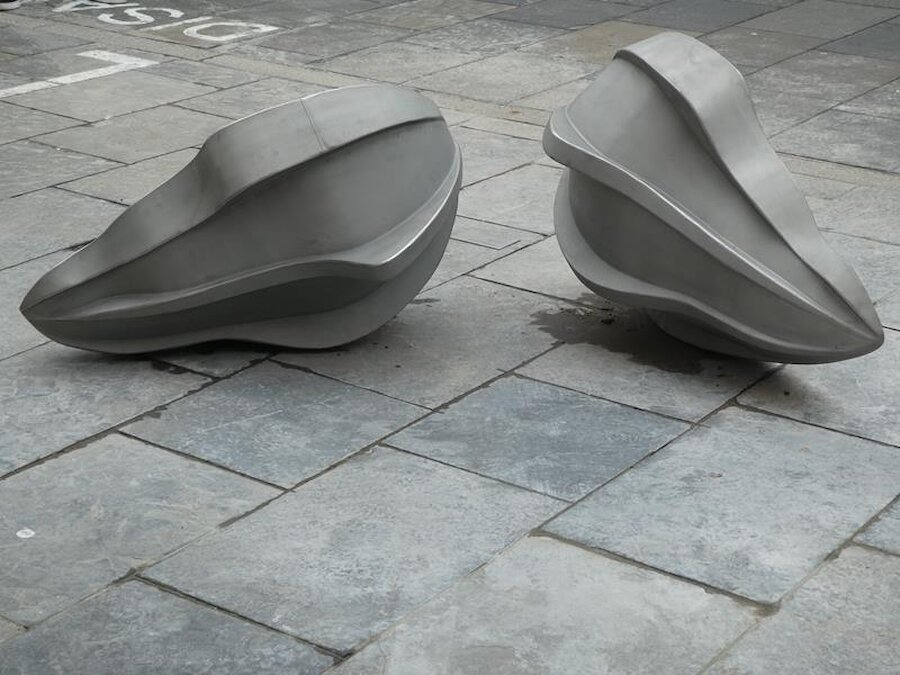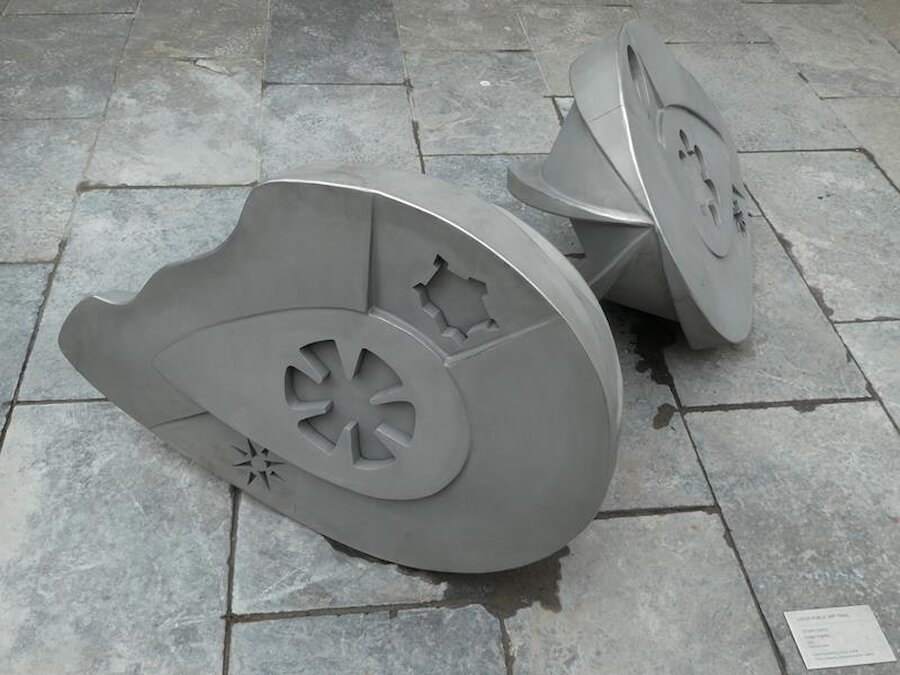Like any community, Shetland thrives through the creativity of its people. Distinctive knitwear, intricate and colourful, is known world-wide; but beyond that the islands have a thriving arts and craft community that draws inspiration from the islands’ environment and heritage. The fusion of fertile imagination with practical skills has made an impact in everything from architecture to computer software to food.
A public art trail, known as LOCUS, has brought four new works to the town centre, inspired by Shetland’s past, present and future. Two more, in the form of murals, are to be added later in the summer.
An informed interest in art and design has been demonstrated over many years. Lerwick’s splendid Town Hall, with stained glass that equals the best secular examples in Britain, is a triumph of Victorian community confidence allied to acute artistic sensibility; it’s also the largest piece of public art in the islands. But there have been other more recent examples, for example a tiled mural that transforms a pumping station in Lerwick into something much less mundane, a detail of which is shown below, or a number of small-scale works in Scalloway; meanwhile, the teaching of art and design skills is one of the strengths of Shetland College.
The new trail is the result of a partnership involving Living Lerwick (which aims to secure a thriving town centre) and Shetland Arts. Financial support has come from the Scottish Government’s Town Centres Fund, which is administered locally by Shetland Islands Council. A beautiful and informative trail leaflet has been designed by Chloe Keppie.
Work on LOCUS started in December 2019, involving residents, community organisations and businesses from across the town, focusing on three key themes: where we are; where we’re going; where we’ve come from. After an open call and selection process, the four commissions for Stage 1 in the project were awarded.
The second stage, consisting of the two murals, drew in additional support from the Town Centre Fund. Four mural designs were created and a public vote determined the winning two, which will be painted by Cobolt Collective and Gavin Renshaw.
The first four works to be installed are Kenny Hunter’s As Above so Below, Civic Soup’s The Never-Ending Gansey, David Lemm’s Stakamillabakka and Joe Ingleby’s Storm Cargo. Thanks to Shetland’s substantial marine engineering sector, it was possible for the four sculptures to be made in Lerwick by local industry partners – Garriock’s, LEF and Malakoff. The only exception was the bronze section of Kenny Hunter’s work, as there is no bronze foundry in Shetland.
Kenny Hunter is a Scottish sculptor who studied at Glasgow School of Art and makes monumental civic sculpture as well as gallery-based work. His public artworks feature in cities and landscapes across the UK and internationally; one of the best-known is the Citizen Fire Fighter outside Glasgow Central Station.
His piece, As above, so below, is the northernmost of the series. It represents the practice of gas extraction from below the seabed to the west of Shetland and acknowledges the important role this industry has played in the development of Shetland’s economy and society. The sculpture is composed as a cross-section of undersea landscape and its geology: the top section represents the gas pipeline, the mid-section the seabed and the plinth the gas-pocket within the earth's crust. These three elements combine to depict the coexistence of industry and nature.
Heading south along Commercial Street, the next piece is by David Lemm, a Scottish artist based in Edinburgh, who graduated from Duncan of Jordanstone College of Art, Dundee. He works in a wide range of media, responding to particular places and found objects.
Stakkamillabakka is a collection of forms based on ‘sea fastenings’ used in local industry to secure loads to boats. They bear some resemblance to blocks used in letterpress printing and this led to David presenting them here as a possible visual language, with the inspiration coming from Shetland dialect, semaphore and runic forms.
The voids and lines of the work create frames for the street scene and the steel framework echoes ladders found around Lerwick’s quays, connecting land and sea. The sculpture can be interpreted as a beacon, aerial or marker point in which the cross design references a compass and Shetland as a historic crossroads of cultural exchange.
From here, one of the Lanes takes the trail up towards the Hillhead, where Civic Soup – an Edinburgh-based architecture and design collective – has created the most colourful of the pieces, The Never-Ending Gansey.
Rooted in Shetland’s textile heritage, the series of forms in powder-coated steel is the result of workshops held in February 2020 across five Shetland schools in which children reimagined Fair Isle patterns in individual motifs and colours.
Returning downhill, the murals will be painted on walls adjacent to, or a little below, Commercial Street.
The Cobolt Collective is a Glasgow-based mural collective of three designers - Erin Bradley-Scott, Chelsea Frew and Kat Loudon. Their design, Only da Sea, takes a line from from the poem “Discontinuity” by Shetland-born poet Christine de Luca: “Only da sea can greet an sing at da sam time". It captures the idea of the sea being a living thing, capable of its own emotions, singing to its own melody and rhythm.
For centuries, the sea has been a place of work and leisure for Shetlanders. It has welcomed new people and said goodbye to others and is home to a wealth of living things from orcas to otters. The rhythm of the waves is like a heartbeat, steady and constant, and a comforting presence for people during difficult times.
The other mural, Push/Pull, is by Gavin Renshaw, a visual artist combining elements of classical painting and graphic design with a graffiti aesthetic. His work can be seen across the UK. Push/Pull, too, is inspired by the sea, exploring its relationship with the land. It does so not only with regard to livelihood and travel but also in the spiritual and primal sense of ancient and future culture. Thus the standing stone looks out to sea; is it a beacon, an ancestor, or a way marker? The yoal (a type of local boat) looks for the stone, a reference to land.
Storm Cargo, formed in stainless steel, consists of two halves, inspired by the shape of a guillemot’s egg. The outer surfaces of the work depict tides, waves, coast and landscape, along with traditional sixareen (six-oared) boat construction. The egg is sliced open to reveal a cargo of elements that make up Shetland: a Scatness wheelhouse and a hearth stone from Jarlshof; Edmondston's Chickweed from Unst; Fort Charlotte; compass navigation; and marine engineering, all as deep cut symbol reliefs.
The two oldest ones are cut deepest, the next two less so, and the most recent has the lightest 'footprint’. The inner plates also angle and wedge, creating a dynamic surface reflecting the stone construction and landscape at Scatness and Jarlshof.
The artists involved in the project have clearly taken time to learn about the heritage of Shetland and islanders’ past and current connections with the land and sea. Although they’ve come up with a wide range of interpretations of the brief, there’s no mistaking, in their work, the strength of the links that they’ve made to Shetland culture.
Public art always stimulates discussion – that’s part of its purpose – and the Locus project is no exception. Particular elements of the work will appeal more to some people than to others. There can certainly be no doubting the quality of the pieces, which have been carefully conceived by leading sculptors and beautifully executed with the skills of local craftspeople. There’s been significant involvement by schools and the community, too. You can find out more about the project and watch a video about it on the Shetland Arts website.
Steve Mathieson, Chair of Living Lerwick, said: “It’s great that the idea of a contemporary art trail for Lerwick has finally come to fruition and thanks must go to Shetland Islands Council for providing us with the funding through the Town Centre Grant Fund, and to Jane Matthews at Shetland Arts for showing great perseverance through these difficult times as Project Manager. We’re very happy that so many local companies have been involved in the actual making of the sculptures and bringing to life the work of the artists and we hope that the trail will bring some additional colour and interest to the town centre for locals and visitors alike.”
Graeme Howell, Chief Executive of Shetland Arts said: “This has been a great partnership project, from working with Living Lerwick on the locations and commissioning, to the work done by the highly skilled local fabricators with the artists to produce these great additions to Lerwick's streets and lanes.”
These new installations will quickly become part of the town’s street scene but they’re also a very useful reminder of that central place that creativity – in so many forms – occupies in the Shetland community. For those directly involved in the arts, and those future generations who may become so, the addition of these new works provide stimulation and encouragement.

